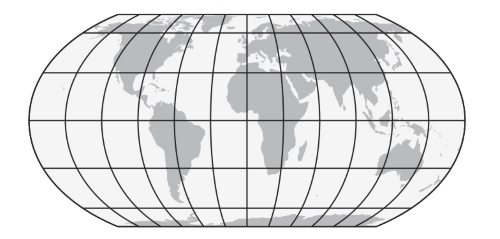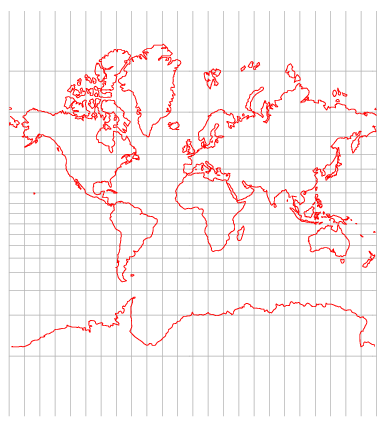
To first approximation, Earth is a sphere. But it bulges at the equator, and to second approximation, Earth is an oblate spheroid. Earth is not exactly an oblate spheroid either, but the error in the oblate spheroid model is about 100x smaller than the error in the spherical model.
Finding the distance between two points on a sphere is fairly simple. Here’s a calculator to compute the distance, and here’s a derivation of the formula used in the calculator.
Finding the distance between two points on an ellipsoid is much more complicated. (A spheroid is a kind of ellipsoid.) Wikipedia gives a description of Vincenty’s algorithm for finding the distance between two points on Earth using an oblate spheroid model (specifically WGS-84). I’ll include a Python implementation below.
Comparison with spherical distance
How much difference does it make when you calculate difference on an oblate spheroid rather than a sphere? To address that question I looked at the coordinates of several cities around the world using the CityData function in Mathematica. Latitude is in degrees north of the equator and longitude is in degrees east of the prime meridian.
|--------------+--------+---------|
| City | Lat | Long |
|--------------+--------+---------|
| Houston | 29.78 | -95.39 |
| Caracas | 10.54 | -66.93 |
| London | 51.50 | -0.12 |
| Tokyo | 35.67 | 139.77 |
| Delhi | 28.67 | 77.21 |
| Honolulu | 21.31 | -157.83 |
| Sao Paulo | -23.53 | -46.63 |
| New York | 40.66 | -73.94 |
| Los Angeles | 34.02 | -118.41 |
| Cape Town | -33.93 | 18.46 |
| Sydney | -33.87 | 151.21 |
| Tromsø | 69.66 | 18.94 |
| Singapore | 1.30 | 103.85 |
|--------------+--------+---------|
Here are the error extremes.
The spherical model underestimates the distance from London to Tokyo by 12.88 km, and it overestimates the distance from London to Cape Town by 45.40 km.
The relative error is most negative for London to New York (-0.157%) and most positive for Tokyo to Sidney (0.545%).
Update: The comparison above used the same radius for both the spherical and ellipsoidal models. As suggested in the comments, a better comparison would use the mean radius (average of equatorial and polar radii) in the spherical model rather than the equatorial radius.
With that change the most negative absolute error is between Tokyo and New York at -30,038 m. The most negative relative error is between London and New York at -0.324%.
The largest positive error, absolute and relative, is between Tokyo and Sydney. The absolute error is 29,289 m and the relative error is 0.376%.
Python implementation
The code below is a direct implementation of the equations in the Wikipedia article.
Note that longitude and latitude below are assumed to be in radians. You can convert from degrees to radians with SciPy’s deg2rad function.
from scipy import sin, cos, tan, arctan, arctan2, arccos, pi
def spherical_distance(lat1, long1, lat2, long2):
phi1 = 0.5*pi - lat1
phi2 = 0.5*pi - lat2
r = 0.5*(6378137 + 6356752) # mean radius in meters
t = sin(phi1)*sin(phi2)*cos(long1-long2) + cos(phi1)*cos(phi2)
return r * arccos(t)
def ellipsoidal_distance(lat1, long1, lat2, long2):
a = 6378137.0 # equatorial radius in meters
f = 1/298.257223563 # ellipsoid flattening
b = (1 - f)*a
tolerance = 1e-11 # to stop iteration
phi1, phi2 = lat1, lat2
U1 = arctan((1-f)*tan(phi1))
U2 = arctan((1-f)*tan(phi2))
L1, L2 = long1, long2
L = L2 - L1
lambda_old = L + 0
while True:
t = (cos(U2)*sin(lambda_old))**2
t += (cos(U1)*sin(U2) - sin(U1)*cos(U2)*cos(lambda_old))**2
sin_sigma = t**0.5
cos_sigma = sin(U1)*sin(U2) + cos(U1)*cos(U2)*cos(lambda_old)
sigma = arctan2(sin_sigma, cos_sigma)
sin_alpha = cos(U1)*cos(U2)*sin(lambda_old) / sin_sigma
cos_sq_alpha = 1 - sin_alpha**2
cos_2sigma_m = cos_sigma - 2*sin(U1)*sin(U2)/cos_sq_alpha
C = f*cos_sq_alpha*(4 + f*(4-3*cos_sq_alpha))/16
t = sigma + C*sin_sigma*(cos_2sigma_m + C*cos_sigma*(-1 + 2*cos_2sigma_m**2))
lambda_new = L + (1 - C)*f*sin_alpha*t
if abs(lambda_new - lambda_old) <= tolerance:
break
else:
lambda_old = lambda_new
u2 = cos_sq_alpha*((a**2 - b**2)/b**2)
A = 1 + (u2/16384)*(4096 + u2*(-768+u2*(320 - 175*u2)))
B = (u2/1024)*(256 + u2*(-128 + u2*(74 - 47*u2)))
t = cos_2sigma_m + 0.25*B*(cos_sigma*(-1 + 2*cos_2sigma_m**2))
t -= (B/6)*cos_2sigma_m*(-3 + 4*sin_sigma**2)*(-3 + 4*cos_2sigma_m**2)
delta_sigma = B * sin_sigma * t
s = b*A*(sigma - delta_sigma)
return s






